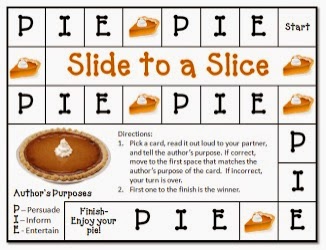There are a ton of great visuals and practice activities out there, but here are just a few of my favorites:
This is a great board game for practicing identifying author's purpose, not to mention it's FREE!
Then there's my favorite visual of Author's Purpose from Mrs. Gilchrist:
I do these things every year but THIS year, I'm turning the lesson around for the students to take charge. After teaching the basic pieces of the P.I.E., I am going to open up the journaling to my student authors.
In order to build the classroom community aspect of the journal, I will be including story starters and examples that support social problem solving in school and the classroom.
If you teach author's purpose AND you want to work on student journaling AND building your classroom community, then check out this packet on my TpT store.
This editable PowerPoint includes:
~Teacher's directions on how to use the product~Student directions on how to use the product
~Persuasive story starters and examples
~Informative story starters and examples
~Entertaining story starters and examples
~The examples for each section are geared toward building your classroom community and fostering deeper thinking
Do you have any other ways to use P.I.E.? I'd love to hear about them!







